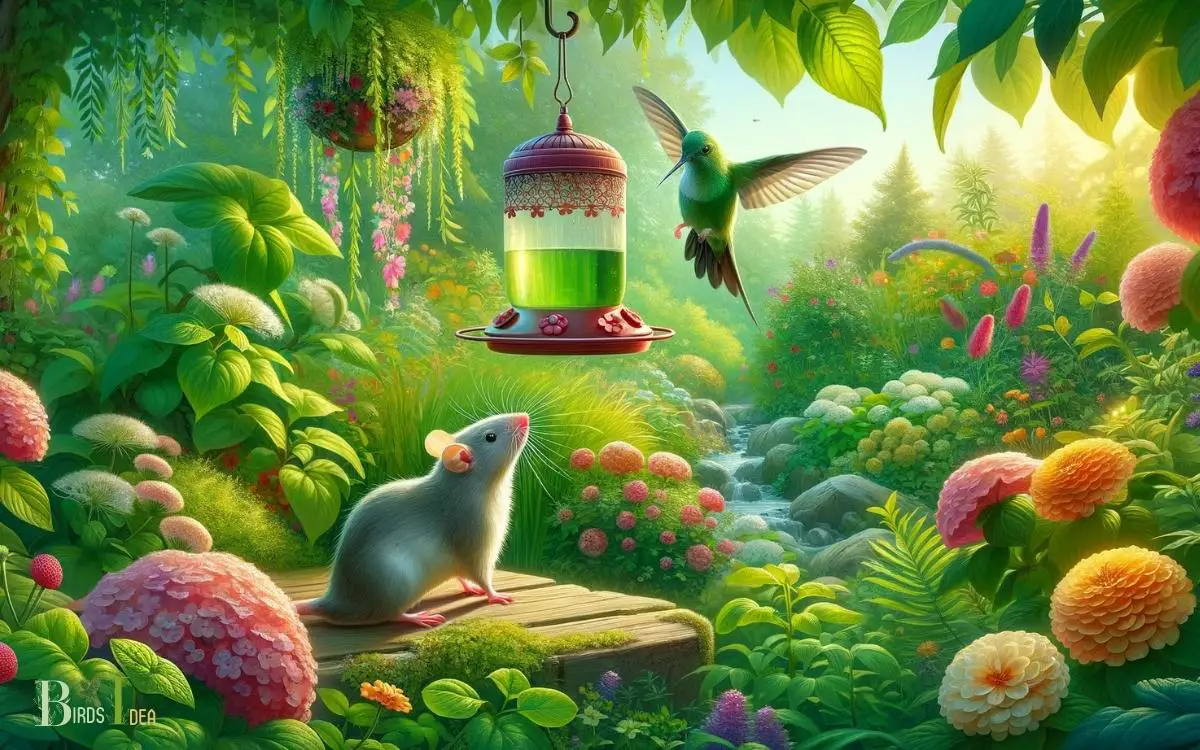Do Hummingbird Feeders Attract Rats? Yes!
Yes, Hummingbird feeders can attract rats, as the sugary nectar serves as a tempting food source for these rodents. Proper maintenance and strategic placement of feeders can help minimize the risk.
Hummingbird feeders contain sweetened water that mimics the nectar found in flowers, which is the natural food for hummingbirds.
However, this sugary solution can also be attractive to other wildlife, including rats. Rats have a keen sense of smell and are always on the lookout for food.
If the feeder leaks or drips, or if the sweet water spills onto the ground, it can catch the attention of these pests.
To prevent attracting rats with hummingbird feeders, consider the following tips:
By taking proactive measures, you can enjoy your hummingbird feeder without inadvertently inviting rodents to the feast
Ensuring that your hummingbird feeders are rat-proof is essential for the health of your local bird population and to prevent unwanted rodent guests.

Key Takeaway
Hummingbird Feeders and Rat Attraction
Overview of Hummingbird Nectar
Hummingbird nectar is a specially formulated solution designed to attract and feed hummingbirds.
It typically consists of a simple mixture of water and granulated white sugar, creating a sweet liquid that mimics the natural nectar found in flowers.
The ratio of sugar to water is crucial, and a common recommendation is a solution of four parts water to one part sugar.
This concentration closely resembles the sugar content in natural nectar, providing the essential energy source for hummingbirds.
Hummingbird feeders are containers that hold this nectar solution and feature feeding ports that allow the birds to access the liquid.
These feeders come in various designs, ranging from simple hanging containers to more intricate designs with multiple feeding stations.
Maintaining the cleanliness of the feeders and regularly replenishing the nectar is crucial to attract and keep hummingbirds returning to your garden.
Rats’ Attraction to Sweet Substances:
Rats are known for their strong sense of smell and opportunistic feeding behavior. They are attracted to a variety of food sources, including sweet substances.
While hummingbird nectar primarily attracts hummingbirds due to its similarity to natural flower nectar, it can inadvertently attract rats as well.
Rats are drawn to the high sugar content in sweet substances, as it provides them with a readily available energy source.
When hummingbird feeders are not properly maintained, spillages, or leakages can occur, leaving sugary residue in the surrounding area.
Rats may then be attracted to this sugary residue, creating potential issues for both the feeder and the surrounding environment.
Factors Attracted Rats to Feeders
Rats are attracted to hummingbird feeders primarily because of the sweet nectar they contain.
Hummingbird feeders are designed to attract hummingbirds with their sugary solution, but unfortunately, other creatures, including rats, may also be drawn to the feeders for the same reason.
Here are some factors that might attract rats to hummingbird feeders:
- Sweet Nectar: The main attractant for rats is the sweet nectar used in hummingbird feeders. Rats have a strong sense of smell and are naturally attracted to sugary substances. If the feeder is leaking or has excess nectar around it, it can easily attract rats.
- Spills and Drips: Hummingbird feeders can sometimes drip or leak, especially in windy or rainy conditions. If the nectar spills onto the ground, it can attract rats searching for an easy food source.
- Poorly Maintained Feeders: If the hummingbird feeder is not properly maintained, it can become a haven for pests. Regular cleaning and maintenance are crucial to prevent the buildup of nectar residue and mold, which may attract rats.
- Feeder Placement: If the hummingbird feeder is placed in an area where rats are common, such as near food waste or in an unsecured location, it increases the likelihood of rats finding and being attracted to the feeder.
- Accessible Food Sources: If there are other food sources nearby, like open garbage bins or bird seed on the ground, rats may be drawn to the area and discover the hummingbird feeder as an additional food source.
Preventive Measures
To prevent rats from being attracted to hummingbird feeders, you can take several preventive measures.
Here are some suggestions:
- Hang Feeders Securely: Place hummingbird feeders in locations that are difficult for rats to reach. Use tall poles or hangers that are not easily climbed by rodents. Ensure that the feeders are hanging away from structures that rats could use to access them.
- Install Baffles: Consider using baffles or barriers around the feeder pole or hanger. These devices are designed to prevent rodents from climbing up and reaching the feeder. Make sure the baffles are positioned far enough from the ground to be effective.
- Use Rat-Resistant Feeders: Some hummingbird feeders are designed with features to deter rats. Look for feeders with built-in ant moats, which can make it more challenging for rats to access the nectar.
- Avoid Overfilling: Fill the hummingbird feeder with just enough nectar to last a few days. Avoid overfilling, as spills and drips can occur, attracting rats. Regularly clean the feeder and the surrounding area to remove any spilled nectar.
- Regular Cleaning: Clean the hummingbird feeders frequently to prevent the buildup of mold and residue. Moldy nectar not only poses a health risk to hummingbirds but can also attract pests like rats.
- Use Rat-Proof Containers: Store any extra hummingbird nectar in sealed, rat-proof containers. This helps prevent spills or leaks that might attract rodents.
- Monitor Other Food Sources: Be mindful of other potential food sources in your garden that may attract rats. Secure garbage bins, clean up fallen birdseed, and eliminate any open food waste that might entice rodents.
- Choose Nectar Alternatives: Consider using hummingbird feeders with less sweet nectar alternatives or making your own nectar with reduced sugar content. While this won’t eliminate the attraction entirely, it may make the feeder less appealing to rats.
- Deterrent Scents: Rats have a keen sense of smell, and certain scents are known to repel them. Consider placing natural deterrents, such as peppermint oil-soaked cotton balls, around the area to discourage rats.
By implementing these preventive measures, you can reduce the likelihood of rats being attracted to hummingbird feeders while still providing a welcoming environment for these fascinating birds.
Hummingbird Feeder Alternatives
While hummingbird feeders can provide a delightful attraction for these tiny birds, it is important to consider alternatives that discourage common rat behavior around feeders.
There are several alternatives to hummingbird feeders that can still attract hummingbirds while minimizing the risk of attracting rats:
- Native Plants: Planting native flowers and shrubs that produce nectar can naturally attract hummingbirds without the need for feeders.
- Drip System: Installing a drip irrigation system in the garden can provide a water source for hummingbirds without the need for standing water in feeders that may attract rats.
- Fruit Trees: Planting fruit-bearing trees can attract hummingbirds with their blossoms and provide natural food sources, reducing the reliance on feeders.
Additional Tips for Hummingbird Enthusiasts
For hummingbird enthusiasts, maintaining a clean and well-maintained feeder is essential to attract these delicate birds and prevent unwanted pests.
To ensure a successful hummingbird feeding experience, consider the following additional tips:
- Regular Cleaning: Clean the feeder with a mild solution of water and vinegar every 3-4 days to prevent mold and bacteria growth, which can be harmful to hummingbirds.
- Proper Placement: Hang the feeder in a shaded area to prevent nectar spoilage and minimize the attraction of insects and other pests.
- Use of Ant Moats: Consider using ant moats to keep ants away from the feeder, as they can deter hummingbirds from visiting.
Following these tips will not only attract more hummingbirds but also ensure a safe and enjoyable environment for these fascinating birds.
Conclusion
In the delicate dance of nature, the hummingbird feeder can be a beacon of beauty and life, but it also has the potential to attract unwanted guests.
By understanding the behavior of both hummingbirds and rodents, and taking proactive steps to prevent infestations, enthusiasts can continue to enjoy the graceful presence of hummingbirds without inviting uninvited visitors to the feast. It’s a delicate balance, much like nature itself.






